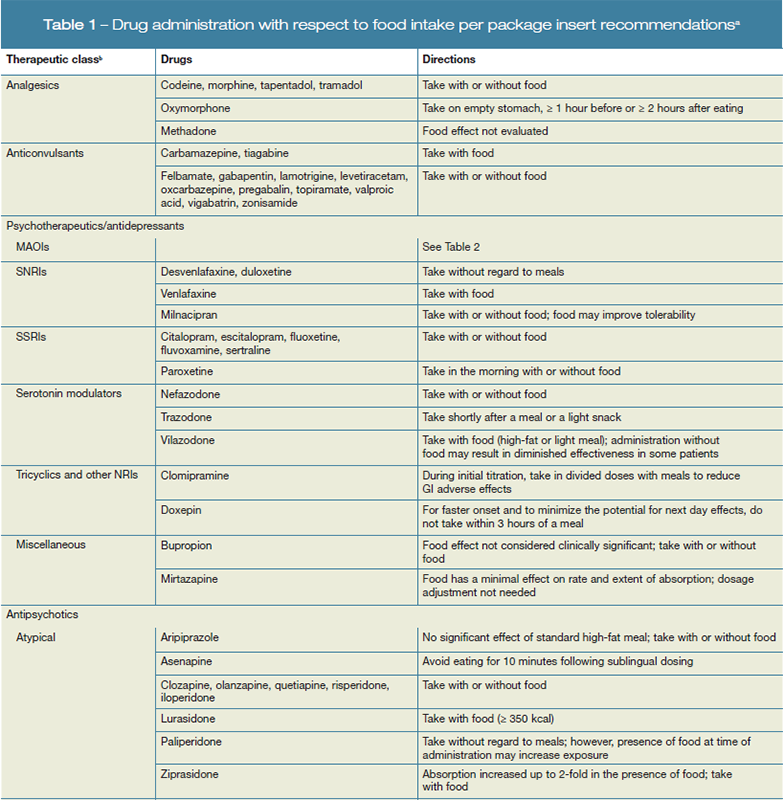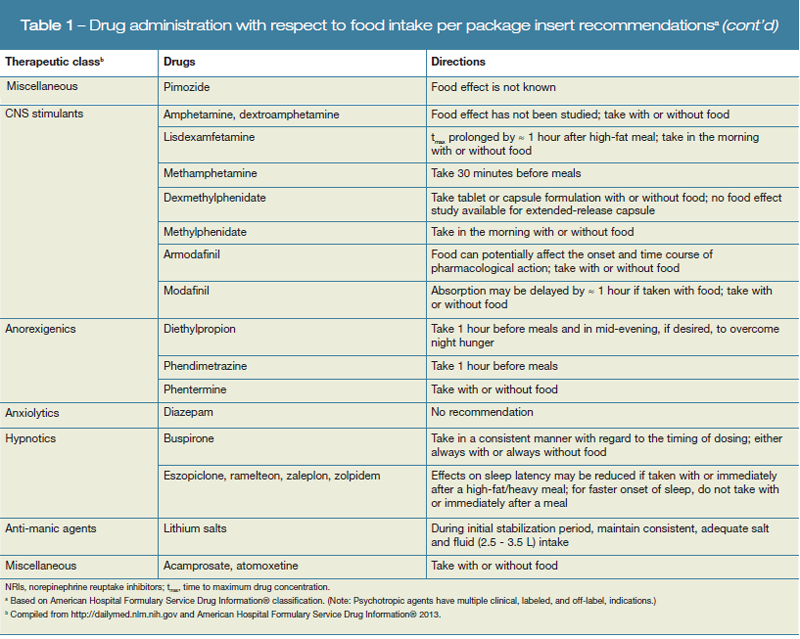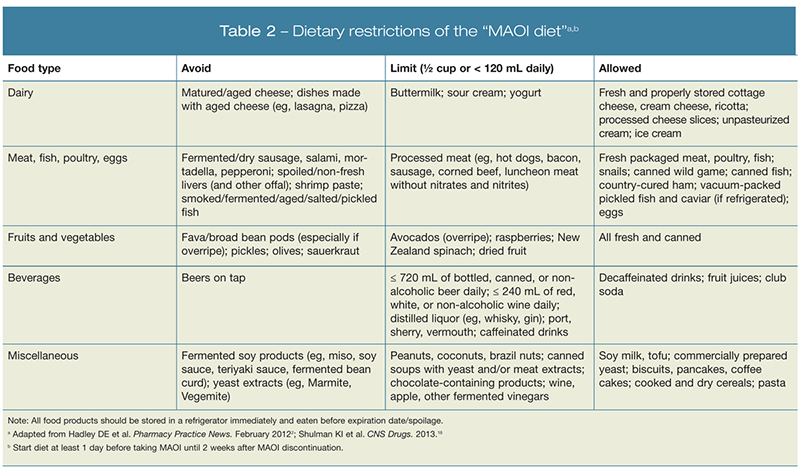Publication
Article
Psychiatric Times
Food-Drug Interactions in Psychiatry: What Clinicians Need to Know
Author(s):
This review focuses on clinically important interactions that occur between foods and medications prescribed for psychiatric disorders.
Table 1 – Drug administration with respect to food intake per package insert recommendations

Table 1 – (cont'd)

Table 2 – Dietary restrictions of the “MAOI diet”

Premiere Date: June 20, 2014
Expiration Date: June 20, 2015 [Expired]
This activity offers CE credits for:
1. Physicians (CME)
2. Other
ACTIVITY GOAL
This article reviews clinically important interactions that occur between foods and medications prescribed for psychiatric disorders, with a focus on underlying mechanisms.
LEARNING OBJECTIVES
At the end of this CE activity, participants should be able to:
1. Understand the mechanisms underlying food-drug interactions.
2. Define the basis for altered pharmacokinetics and pharmacodynamics.
3. Identify the role of metabolism in food-drug interactions.
TARGET AUDIENCE
This continuing medical education activity is intended for psychiatrists, psychologists, primary care physicians, physician assistants, nurse practitioners, and other health care professionals who seek to im-prove their care for patients with mental health disorders.
CREDIT INFORMATION
CME Credit (Physicians):This activity has been planned and implemented in accordance with the Essential Areas and policies of the Accreditation Council for Continuing Medical Education through the joint sponsorship of CME Outfitters, LLC, and Psychiatric Times. CME Outfitters, LLC, is accredited by the ACCME to provide continuing medical education for physicians.
CME Outfitters designates this enduring material for a maximum of 1.5 AMA PRA Category 1 Credit™. Physicians should claim only the credit commensurate with the extent of their participation in the activity.
Note to Nurse Practitioners and Physician Assistants: AANPCP and AAPA accept certificates of participation for educational activities certified for AMA PRA Category 1 Credit™.
DISCLOSURE DECLARATION
It is the policy of CME Outfitters, LLC, to ensure independence, balance, objectivity, and scientific rigor and integrity in all of their CME/CE activities. Faculty must disclose to the participants any relationships with commercial companies whose products or devices may be mentioned in faculty presentations, or with the commercial supporter of this CME/CE activity. CME Outfitters, LLC, has evaluated, identified, and attempted to resolve any potential conflicts of interest through a rigorous content validation procedure, use of evidence-based data/research, and a multidisciplinary peer-review process.
The following information is for participant information only. It is not assumed that these relationships will have a negative impact on the presentations.
Christina S. Won, PharmD, PhD, has no disclosures to report.
Rabia Bushra, MD (peer/content reviewer), has no disclosures to report.
Applicable Psychiatric Times staff have no disclosures to report.
UNLABELED USE DISCLOSURE
Faculty of this CME/CE activity may include discussion of products or devices that are not currently labeled for use by the FDA. The faculty have been informed of their responsibility to disclose to the audience if they will be discussing off-label or investigational uses (any uses not approved by the FDA) of products or devices. CME Outfitters, LLC, and the faculty do not endorse the use of any product outside of the FDA-labeled indications. Medical professionals should not utilize the procedures, products, or diagnosis techniques discussed during this activity without evaluation of their patient for contraindications or dangers of use.
Questions about this activity? Call us at 877.CME.PROS (877.263.7767).
The act of food consumption is integral to the body’s response to foreign substances, such as environmental toxins and pharmacological agents. Diet has the greatest opportunity to affect drug disposition, since most drugs and foods enter the body via the oral route and are subject to the same (sometimes competing) processes of absorption, distribution, metabolism, and excretion. The likelihood and magnitude of an interaction depends on several variables: physicochemical properties of a drug (ie, pH, solubility); food composition and timing; postprandial changes in the GI tract, and patient characteristics (eg, dietary habits, nutrition status).1 This review focuses on clinically important interactions that occur between foods and medications prescribed for psychiatric disorders. Underlying mechanisms, examples, and clinical recommendations are presented.
Food-drug interactions can manifest as altered pharmacokinetics (PK) and/or pharmacodynamics (PD) of a drug. Drug absorption, distribution, and elimination may be enhanced or inhibited by food, which can lead to decreased or increased systemic drug concentration. Food can also interfere with a drug’s binding to its receptor, leading to decreased or increased effectiveness. Psychotropic agents can exert serious adverse effects (eg, profound sedation, hypertensive crisis, QTc prolongation) as well as potentially devastating behavioral outcomes due to decreased or lack of therapeutic effectiveness.2
The effects of food
Potential clinical significance of food-drug interactions is recognized by regulatory agencies, each with specific guidelines. In 2002, the FDA released a guidance for the design and conduct of studies on the effects of food as well as the effects of fasted vs fed states.3 According to the FDA, high-calorie (approximately 800 to 1000 calories) and high-fat (approximately 50% of total caloric content) meals are more likely to produce the greatest adverse effects on GI physiology and subsequent systemic drug availability.
On the basis of the magnitude of change in systemic drug exposure (area under the concentration curve [AUC]), maximum drug concentration (Cmax), and/or time to Cmax (tmax), compared with fasting conditions, a drug can be “taken with or without food.” Food marginally increases quetiapine Cmax and AUC by 25% and 15%, respectively.4 Therefore, quetiapine can be taken with or without food. In contrast, a food effect study in 30 healthy male volunteers given zolpidem while fasting or 20 minutes after a meal showed that food decreased mean Cmax and AUC by 15% and 25%, respectively, and increased tmax by 60% (1.4 to 2.2 hours).5,6 Because of the potential for delayed onset of sleep, zolpidem is not to be taken with or immediately after a meal.5
For some drugs, the clinical implication of a food effect is unknown. Diazepam absorption was decreased and delayed by approximately 30 minutes when administered with a moderate-fat meal compared with fasting: tmax was increased by 1.25 hours; Cmax and AUC were decreased, on average, by 20% and 27%, respectively; however, the label does not provide a recommendation.7Table 1 lists psychotropic agents with explicit instructions on drug and food intake as specified in the package insert.
Mechanisms of altered drug exposure and response
An understanding of the various effects of food and/or food components on drug behavior is the basis for optimizing therapy. Interference from a food or food component depends on numerous variables, ranging from physicochemical properties of the drug to physiological changes in the GI tract after a meal. Components of the diet that modulate drug-metabolizing enzymes (eg, cytochrome P-450 [CYP450] enzymes, phase II conjugation enzymes) and transport proteins (eg, P-glycoprotein) are increasingly recognized as contributors to food effects on drug disposition.8
Changes in these physiological, physicochemical, and biochemical interactions can be evaluated using drug PK measures such as clearance, systemic exposure/AUC, Cmax, tmax, and bioavailability. It is important to note that such measures are clinically relevant if patient response (or nutrition status) is compromised. An increase in systemic drug exposure may augment the risk of adverse events and toxicity; a decrease in exposure may lead to therapeutic failure. Despite the lack of an established PK-PD relationship, clinicians should not discount the relevance of a theoretical food-drug interaction, especially for drugs with a narrow therapeutic index (ie, lithium, carbamazepine, phenytoin).
Absorption
The GI tract poses a formidable barrier to successful delivery of an orally administered drug to the site of action. However, chelation is a more fundamental obstacle to absorption. Binding between the drug and food is a physicochemical interaction that can lead to decreased absorption. For example, proteins and salts in enteral nutrition formulas bind to phenytoin, resulting in reduced absorption. Although irrelevant to psychotropic therapies, a noteworthy classic example is the complexation of foods containing divalent cations (eg, calcium, magnesium) and drugs such as levothyroxine, tetracyclines, and fluoroquinolones. In contrast, high-fat meals can increase bioavailability of some drugs, such as the antiretroviral protease inhibitors nelfinavir and saquinavir.
It is interesting to note that ziprasidone and lurasidone are the only psychiatric medications with specific calorie requirements to aid absorption. The precise mechanism is still unknown. The package insert for ziprasidone recommends concomitant intake with food, which provides an up to 2-fold increase in absorption.9 More specifically, a clinical trial that evaluated the effects of different caloric and fat content on ziprasidone systemic exposure showed that a meal with 500 kcal or more (irrespective of fat content) is required for optimal bioavailability.10
The package insert for lurasidone recommends concomitant intake with 350 kcal or more, because lurasidone Cmax and AUC are increased approximately 3- and 2-fold, respectively, compared with fasting condi-tions.11 (Lurasidone exposure was not affected as calorie content was increased from 350 to 1000 kcal and was independent of meal fat content.)
Food and/or food components can alter the rate and extent of drug absorption by affecting physiological processes and/or “mechanics” of the GI tract. Such mechanisms include delayed gastric emptying, increased bile or splanchnic blood flow, and gastric pH changes. For example: amphetamines are well absorbed under alkaline conditions; acidic foods and beverages such as fruit juices and soft drinks may decrease gastric pH and subsequent amphetamine absorption.
Distribution
Drug molecules can bind to plasma proteins such as albumin and α1-acid glycoprotein, depending on physicochemical properties and the amount of plasma proteins in the patient’s blood (which can be influenced by nutrition status). Highly protein-bound psychotropic agents (more than 95%), such as valproic acid, antipsychotics, and SSRIs, are susceptible to displacement by other drugs and nutrients binding to the same site(s). However, clinically significant food-drug (and drug-drug) interactions due to plasma protein binding are rare. A suspected interaction should be confirmed with therapeutic drug monitoring (ie, free drug level).
Metabolism
The CYP450 family is the predominant group of phase I enzymes involved in drug metabolism. Psychotropic medications are typically metabolized by one or more of the following isoforms: 3A4, 2D6, 2C8/9/19, 2B6, and 1A2. Certain foods and specific dietary substances can inhibit or induce these CYP isoforms, leading to increased or decreased systemic drug exposure. Clinical significance of these interactions depends on several factors, including metabolic contribution of specific CYP isoforms, amount and frequency of dietary substance, site (intestine and/or liver), and timing.
Few foods are capable of clinically significant CYP induction. Char-grilled meat and broccoli (consumed for longer than 5 days) have been shown to induce CYP1A2 activity, as demonstrated by increased metabolism of caffeine (ie, CYP1A probe).12-14 Clozapine, olanzapine, and duloxetine are partially metabolized by CYP1A2; an interaction with the aforementioned foods would result in decreased drug exposure. However, no formal studies on this theoretical interaction have been reported.
[[{"type":"media","view_mode":"media_crop","fid":"25056","attributes":{"alt":"food-drug interactions","class":"media-image media-image-right","id":"media_crop_6747763639391","media_crop_h":"0","media_crop_image_style":"-1","media_crop_instance":"2239","media_crop_rotate":"0","media_crop_scale_h":"145","media_crop_scale_w":"200","media_crop_w":"0","media_crop_x":"0","media_crop_y":"0","style":"float: right; height: 167px; width: 230px;","title":" ","typeof":"foaf:Image"}}]]Grapefruit juice has been shown to inhibit the metabolism of various CYP3A substrates. It can be a strong or moderate inhibitor of CYP3A-mediated first-pass metabolism in the intestine. Although inhibition is localized in the intestine, increased systemic drug exposure is sufficient to produce adverse effects, such as excessive sedation with buspirone and diazepam. Some CYP3A substrates (eg, clozapine, alprazolam, haloperidol) have not been shown to be affected by grapefruit juice.15 However, lack of an observed interaction may be attributed to insufficient or no analysis of the causative inhibitory constituents, one of the most important factors to consider. Since the majority of grapefruit juice–drug interaction studies do not report furanocoumarin content, it is difficult to reconcile conflicting results or compare between studies.
Excretion
Food and nutrients may act to alter drug reabsorption by renal tubules and excretion in urine. For example, lithium is a monovalent ion like sodium, and it is excreted unchanged primarily in urine. Since the kidneys do not distinguish between the two ions, large fluctuations in dietary sodium can change lithium concentration. Lithium decreases sodium reabsorption by the proximal tubule, leading to sodium depletion. Reduced sodium intake can lead to lithium reabsorption, whereas increased sodium consumption can increase lithium excretion. Patients should be advised to maintain consistent salt and caffeine intake as well as adequate hydration (2.5 to 3.5 L) during the initial stabilization period.
PD-based food-drug interactions occur when food modifies the effect of a drug. Certain food components can enhance or antagonize pharmacological actions at the site(s) of action (eg, receptor) or other mechanisms in the same tissue. Changes in PD end points can be evaluated using qualitative (eg, symptom score, vital signs) and/or quantitative (eg, biomarker levels) measures that may be primary or surrogate indicators of drug action.
Wine, beer, and distilled liquor are CNS depressants, and concomitant intake is not recommended because of additive effects for drowsiness, dizziness, and impaired cognition.16 Caffeine, on the other hand, is a stimulant, and excessive intake can potentiate drug adverse effects such as tachycardia, anxiety, restlessness, and tremor.
The most well-known PD-based interaction occurs between MAOIs and tyramine. Tyramine is a monoamine produced by MAO-mediated metabolism of tyrosine in some foods. In addition to tyramine, MAO breaks down neurotransmitters such as dopamine, norepinepherine, and serotonin. Inhibition of MAO by certain antidepressants and unrestricted consumption of tyramine can lead to severe hypertension, arrhythmia, and headache. Many foods were originally contraindicated, but recent data suggest a less restricted list of foods to be avoided (Table 2).17,18
Patients should be warned that tyramine content may vary, and levels increase when foods are aged or fermented, are stored for a long time (even in a refrigerator), or are not fresh. Given these variables and the erratic GI absorption of tyramine, lack of a serious reaction from (accidental) consumption of a restricted food on one occasion is not guaranteed on a different occasion.
Nutraceuticals
Although investigation of the “food effect” on drug exposure is standard practice, the issue may not be as simple as “take with or without food.” Specific dietary supplements and herbs have been shown to alter drug PK and PD.19 These interactions are challenging to assess because, unlike most drug products, dietary and herbal substances are compounds, composed of multiple, and usually unknown, bioactive ingredients. Use of such products as adjuncts to prescribed medication(s) has increased over the past decade, although concomitant therapy is not recommended.
Special populations
The interaction between food, nutrients, and drugs can be difficult to discern in terms of the precise effects of these relationships in the body. Added complexity from immature, aging, or pregnant physiologies creates added uncertainty. Drug-drug interactions for specific populations may be addressed in the package insert and specialized guides. However, food-drug interaction research in these vulnerable populations is sparse.
Conclusion
The risk of food-drug interactions is expected to increase with the rising trend of polypharmacy and the diverse food products/ingredients available on the market. Some interactions may be avoided simply by separation of drug administration and food intake (by minutes or hours) or manipulation of the dosage form (eg, delayed-release, enteric coating). Other strategies may be applied depending on each patient situation. The following are general recommendations:
• Read the package insert or patient counseling pamphlet for instructions on dose administration
• Titrate doses and administration time(s) relative to meals and meal composition
• Advise patients to inform prescriber(s) if significant changes in the diet are planned or have occurred before or during therapy initiation or titration (some medications suppress or stimulate appetite as a mechanism of action or adverse effect)
• Exercise caution when interpreting results from drug interactionâchecking software, which may overreport
Expired: The Post-Test is no longer available online at www.cmeoutfitters.com/UB030.
References:
1. Chan LN. Drug-nutrient interaction in clinical nutrition. Curr Opin Clin Nutr Metab Care. 2002;5:327-332.
2. Hadley DE, Albanese WP III, Rochester CD. Psychiatric drug interactions explored: from the literature to clinical practicality. Pharmacy Practice News. February 2012;7-12.
3. US Food and Drug Administration. Guidance for Industry: Food-Effect Bioavailability and Fed Bioequivalence Studies. http://www.fda.gov/downloads/regulatoryinformation/guidances/ucm126833.pdf. Accessed April 24, 2014.
4. Seroquel [package insert]. Wilmington, DE: AstraZeneca Pharmaceuticals LP; 2013.
5. Ambien [package insert]. Bridgewater, NJ: sanofi-aventis US LLC; 2013.
6. Greenblatt DJ, Harmatz JS, Singh NN, et al. Influence of food on pharmacokinetics of zolpidem from fast dissolving sublingual zolpidem tartrate tablets. J Clin Pharmacol. 2013;53:1194-1198.
7. Valium [package insert]. San Francisco: Roche; 2013.
8. RodrÃguez-Fragoso L, MartÃnez-Arismendi JL, Orozco-Bustos D, et al. Potential risks resulting from fruit/vegetable-drug interactions: effects on drug-metabolizing enzymes and drug transporters. J Food Sci. 2011;76:R112-R124.
9. Lincoln J, Stewart ME, Preskorn SH. How sequential studies inform drug development: evaluating the effect of food intake on optimal bioavailability of ziprasidone. J Psychiatr Pract. 2010;16:103-114.
10. Gandelman K, Alderman JA, Glue P, et al. The impact of calories and fat content of meals on oral ziprasidone absorption: a randomized, open-label, crossover trial. J Clin Psychiatry. 2009;70:58-62.
11. Latuda [package insert]. Marlborough, MA: Sunovion Pharmaceuticals Inc; 2013.
12. Fontana RJ, Lown KS, Paine MF, et al. Effects of a chargrilled meat diet on expression of CYP3A, CYP1A, and P-glycoprotein levels in healthy volunteers. Gastroenterology. 1999;117:89-98.
13. Kall MA, Clausen J. Dietary effect on mixed function P450 1A2 activity assayed by estimation of caffeine metabolism in man. Hum Exp Toxicol. 1995;14:801-807.
14. Kall MA, Vang O, Clausen J. Effects of dietary broccoli on human in vivo drug metabolizing enzymes: evaluation of caffeine, oestrone and chlorzoxazone metabolism. Carcinogenesis. 1996;17:793-799.
15. Mertens-Talcott SU, Zadezensky I, De Castro WV, et al. Grapefruit-drug interactions: can interactions with drugs be avoided? J Clin Pharmacol. 2006;46:1390-1416.
16. Jang GR, Harris RZ. Drug interactions involving ethanol and alcoholic beverages. Expert Opin Drug Metab Toxicol. 2007;3:719-731.
17. Gardner DM, Shulman KI, Walker SE, Tailor SA. The making of a user friendly MAOI diet. J Clin Psychiatry. 1996;57:99-104.
18. Shulman KI, Herrmann N, Walker SE. Current place of monoamine oxidase inhibitors in the treatment of depression. CNS Drugs. 2013;27:789-797.
19. Stargrove MB, Treasure J, McKee DL. Herb, Nutrient, and Drug Interactions: Clinical Implications and Therapeutic Strategies. St Louis: Mosby Elsevier; 2008.








